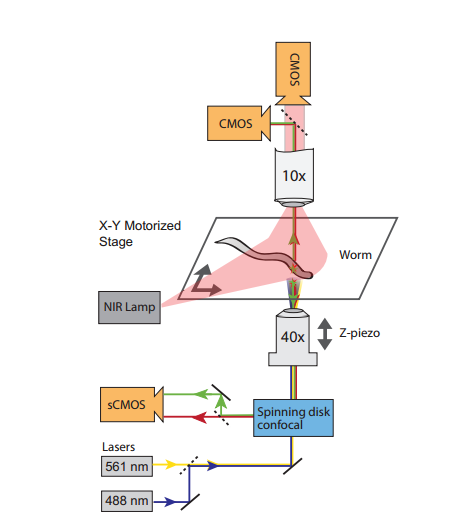First Videos Created of Whole Brain Neural Activity in an Unrestrained Animal
The fundamental challenge of neuroscience is to understand how the nervous system controls an animal’s behavior. In recent years, neuroscientists have made great strides in determining how the collective activity of many individual neurons is critical for controlling behaviors such as arm reach in primates, song production in the zebrafinch and the choice between swimming or crawling in leeches.

The problem is that neuroscientists can only study the role that small groups of neurons play in these behaviors. That’s largely because it is hard to watch the individual behaviors of densely packed neurons. So imaging techniques focus on small regions of the brain, generally in animals that have been immobilized.
So a way of imaging the neural activity of an entire brain in a moving animal would be a significant breakthrough. Today, Jeffrey Nguyen and pals at Princeton University in New Jersey, say they have done just this for the first time. These guys have captured the neural activity in the entire brains of nematode worms that are able to move freely in a petri dish.
The technique is relatively straightforward. To capture images of an unrestrained worm, they use an image recognition system to track its movement in real-time and adjust a motorized stage to keep it within the field of view of a confocal microscope.
They then use a standard technique of calcium fluorescent imaging to photograph the neural activity in a thin slice of the nematode’s brain. This works by genetically modifying the worms to express a fluorescent protein that glows when neurons produce calcium ions, which are widely thought to be a proxy for neural activity.
By photographing other brain slices, the team was able to build a three-dimensional picture of the entire brain activity. And by doing this at a rate of 200 frames per second, they were able to capture five brain volumes per second as the worm moves. You can watch the videos here.
The results are the first insight into brain activity and its relation to whole-body movement, which the team also recorded with a separate camera.
The nematode worm is an ideal subject for this kind of study because its nervous system of 302 neurons has been entirely mapped. Nguyen and co observed activity in 78 of these neurons and found that they showed significant correlations to movements such as forward, backward and turning locomotion.
The team says it has compared its results with previous studies of single neurons and say they are consistent but at the same time have found evidence of entirely new behavioral circuits. “We believe this work represents a significant advance towards studying population dynamics of a brain-sized neural network for coding behavior,” they say.
That’s an impressive piece of work that has significant potential for the future. However, there are some challenges ahead. Perhaps the most important is that nobody knows how neurons in the brain link to neurons in the body. “Future work is needed to solve this neural identity challenge,” admit Nguyen and co.
But that is surely a problem that many researchers will take on given this new breakthrough. One thing is for sure, neuroscience has a powerful new Imaging technique on its hands.
Ref: arxiv.org/abs/1501.03463 : Whole-Brain Calcium Imaging With Cellular Resolution In Freely Behaving C. Elegans
Keep Reading
Most Popular
Large language models can do jaw-dropping things. But nobody knows exactly why.
And that's a problem. Figuring it out is one of the biggest scientific puzzles of our time and a crucial step towards controlling more powerful future models.
How scientists traced a mysterious covid case back to six toilets
When wastewater surveillance turns into a hunt for a single infected individual, the ethics get tricky.
The problem with plug-in hybrids? Their drivers.
Plug-in hybrids are often sold as a transition to EVs, but new data from Europe shows we’re still underestimating the emissions they produce.
Stay connected
Get the latest updates from
MIT Technology Review
Discover special offers, top stories, upcoming events, and more.